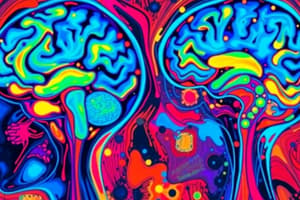Podcast
Questions and Answers
Which of the following brain structures is most closely associated with emotion processing?
Which of the following brain structures is most closely associated with emotion processing?
- Amygdala (correct)
- Hippocampus
- Cerebellum
- Thalamus
The amygdala is part of which brain system?
The amygdala is part of which brain system?
- Peripheral nervous system
- Extrapyramidal system
- Endocrine system
- Limbic system (correct)
The primary role of the amygdala is:
The primary role of the amygdala is:
- Processing emotions (correct)
- Regulating heart rate
- Language comprehension
- Coordinating motor movement
The amygdala receives sensory input from:
The amygdala receives sensory input from:
Which emotion is the amygdala most strongly associated with?
Which emotion is the amygdala most strongly associated with?
Overactivation of the amygdala has been linked to:
Overactivation of the amygdala has been linked to:
Which structure has extensive bidirectional connections with the amygdala and is important for decision-making?
Which structure has extensive bidirectional connections with the amygdala and is important for decision-making?
The amygdala is linked to which type of learning?
The amygdala is linked to which type of learning?
Which neurotransmitter is primarily involved in fear-related responses in the amygdala?
Which neurotransmitter is primarily involved in fear-related responses in the amygdala?
Which psychiatric disorder has been strongly linked to amygdala dysfunction?
Which psychiatric disorder has been strongly linked to amygdala dysfunction?
Damage to the amygdala impairs the recognition of which facial expression the most?
Damage to the amygdala impairs the recognition of which facial expression the most?
The amygdala is located in which part of the brain?
The amygdala is located in which part of the brain?
The amygdala plays a key role in linking perception of stimuli to:
The amygdala plays a key role in linking perception of stimuli to:
Which two major brain structures are involved in emotion processing alongside the amygdala?
Which two major brain structures are involved in emotion processing alongside the amygdala?
What happens when the amygdala is overactivated in PTSD?
What happens when the amygdala is overactivated in PTSD?
The amygdala is involved only in processing fear-related emotions.
The amygdala is involved only in processing fear-related emotions.
The amygdala plays a role in both emotional processing and decision-making.
The amygdala plays a role in both emotional processing and decision-making.
The amygdala is located in the occipital lobe of the brain.
The amygdala is located in the occipital lobe of the brain.
The amygdala and hippocampus are connected and work together in memory processing.
The amygdala and hippocampus are connected and work together in memory processing.
The amygdala has bidirectional connections with the orbitofrontal cortex, which helps in decision-making.
The amygdala has bidirectional connections with the orbitofrontal cortex, which helps in decision-making.
The amygdala only processes conscious emotional stimuli.
The amygdala only processes conscious emotional stimuli.
Damage to the amygdala can cause difficulty recognizing fear in facial expressions.
Damage to the amygdala can cause difficulty recognizing fear in facial expressions.
PTSD has been linked to overactivation of the amygdala.
PTSD has been linked to overactivation of the amygdala.
The amygdala receives and processes sensory information from multiple sources.
The amygdala receives and processes sensory information from multiple sources.
The fight-or-flight response is associated with amygdala activity.
The fight-or-flight response is associated with amygdala activity.
Functional MRI (fMRI) studies have shown abnormal amygdala activation in individuals with autism spectrum disorder.
Functional MRI (fMRI) studies have shown abnormal amygdala activation in individuals with autism spectrum disorder.
The amygdala is a unilateral structure, meaning it is only present on one side of the brain.
The amygdala is a unilateral structure, meaning it is only present on one side of the brain.
Fear conditioning is a process involving the amygdala that helps organisms learn to respond to danger.
Fear conditioning is a process involving the amygdala that helps organisms learn to respond to danger.
The amygdala helps link external stimuli with autonomic and endocrine responses.
The amygdala helps link external stimuli with autonomic and endocrine responses.
The amygdala plays a role in social behavior and emotional recognition, making it relevant in autism research.
The amygdala plays a role in social behavior and emotional recognition, making it relevant in autism research.
Flashcards
Amygdala and Emotion Processing
Amygdala and Emotion Processing
The amygdala is primarily responsible for emotion processing, especially fear.
Limbic System
Limbic System
A collection of brain structures involved in emotion, memory, and motivation, including the amygdala.
Role of Amygdala
Role of Amygdala
The primary role of the amygdala is processing emotions and linking them to sensory input.
Sensory Input and Amygdala
Sensory Input and Amygdala
Signup and view all the flashcards
Emotion Most Associated with Amygdala
Emotion Most Associated with Amygdala
Signup and view all the flashcards
Overactivation Effects
Overactivation Effects
Signup and view all the flashcards
Orbitofrontal Cortex and Amygdala
Orbitofrontal Cortex and Amygdala
Signup and view all the flashcards
Fear Conditioning
Fear Conditioning
Signup and view all the flashcards
Neurotransmitter in Amygdala
Neurotransmitter in Amygdala
Signup and view all the flashcards
Psychiatric Disorders and Amygdala
Psychiatric Disorders and Amygdala
Signup and view all the flashcards
Recognition of Fear
Recognition of Fear
Signup and view all the flashcards
Location of Amygdala
Location of Amygdala
Signup and view all the flashcards
Linking Perception and Emotion
Linking Perception and Emotion
Signup and view all the flashcards
Structures in Emotion Processing
Structures in Emotion Processing
Signup and view all the flashcards
PTSD and Amygdala
PTSD and Amygdala
Signup and view all the flashcards
Amygdala and Fear Response
Amygdala and Fear Response
Signup and view all the flashcards
Functional MRI and Autism
Functional MRI and Autism
Signup and view all the flashcards
Fear Conditioning Process
Fear Conditioning Process
Signup and view all the flashcards
Amygdala and Stress Responses
Amygdala and Stress Responses
Signup and view all the flashcards
Social Behavior and Amygdala
Social Behavior and Amygdala
Signup and view all the flashcards
Connections Between Structures
Connections Between Structures
Signup and view all the flashcards
Bilateral Structure
Bilateral Structure
Signup and view all the flashcards
Multiple Emotions and Amygdala
Multiple Emotions and Amygdala
Signup and view all the flashcards
Hippocampus and Amygdala Interaction
Hippocampus and Amygdala Interaction
Signup and view all the flashcards
Unconscious Processing
Unconscious Processing
Signup and view all the flashcards
Abnormal Activation in Disorders
Abnormal Activation in Disorders
Signup and view all the flashcards
Facial Expression Recognition
Facial Expression Recognition
Signup and view all the flashcards
Study Notes
Emotion Processing and the Amygdala
- The amygdala is the primary brain structure responsible for emotion processing, particularly fear and threat detection.
- The limbic system is a group of brain structures involved in emotion, memory, and motivation. The amygdala is a key component of this system.
- The amygdala's primary role is processing emotions and connecting them to sensory stimuli.
- The amygdala receives input from multiple sensory systems (e.g., visual, auditory, olfactory).
- The amygdala is strongly associated with fear, but also processes other emotions.
- Overactivation of the amygdala is linked to heightened emotional responses, anxiety disorders, and PTSD.
- The amygdala works with the orbitofrontal cortex in decision-making and emotional regulation.
- Fear conditioning is a learning process where the amygdala helps associate stimuli with fear responses.
- The amygdala plays a key role in both emotional processing and decision-making, particularly through connections with the orbitofrontal cortex.
- The amygdala is located in the temporal lobe of the brain.
- The amygdala is involved in fight-or-flight responses, preparing the body to react to danger.
- Autism research indicates abnormal activation of the amygdala during emotional processing.
- The amygdala is a bilateral structure, meaning it exists on both sides of the brain.
- The amygdala is critical in linking emotions to memories and autonomic/endocrine responses.
- The amygdala has extensive bidirectional connections with other brain structures, such as the hippocampus and the orbitofrontal cortex, which are important for decision making.
- Damage to the amygdala can cause difficulty recognizing fear in facial expressions.
Neurotransmitters
- Glutamate is a primary excitatory neurotransmitter in the amygdala, influencing fear and emotion.
Psychiatric Disorders
- Damage or dysfunction in the amygdala is linked to schizophrenia, autism, PTSD, and anxiety disorders.
- Abnormal amygdala activation is observed in individuals with autism spectrum disorder.
Studying That Suits You
Use AI to generate personalized quizzes and flashcards to suit your learning preferences.



